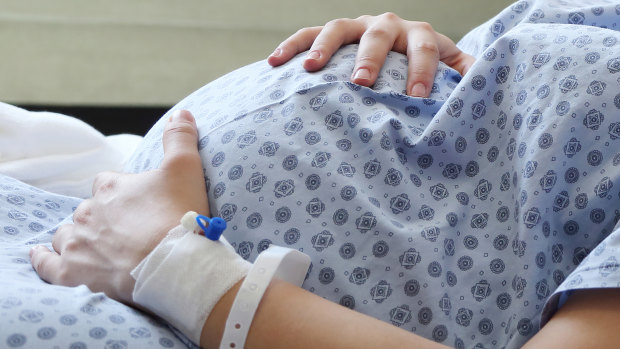Australia’s private maternity hospitals face collapse without major reforms to combat the soaring costs of running the services for a shrinking pool of women, who pay thousands in out-of-pocket fees and increasingly unaffordable health insurance.
Operators say insurers must include maternity in lower policy tiers, after several private maternity hospitals shut, pushing more women into the overburdened public system.
The situation is symptomatic of the crisis afflicting the $22 billion private hospital sector – now the subject of an urgent federal government review – driven by soaring workforce costs, as well as electricity and medico-legal bills.

Roughly one in four deliveries in Australia is in a private hospital, Australian Institute of Health and Welfare data shows. Credit: Getty Images
“This isn’t about a few private women not being able to have a nice hospital room,” said Dr Gino Pecoraro, president of the National Association of Specialist Obstetricians and Gynaecologists (NASOG), the peak body for private obstetricians.
“The collapse of private obstetrics will have a huge flow-on effect.”
One in four women gives birth in a private maternity hospital. Pecoraro said any substantial contraction of the private sector would put intense pressure on public hospitals.
“We know the public system is overburdened. If you have a normal vaginal delivery you are kicked out after four hours, after an elective caesarean [you are discharged] after 24 hours, and for an emergency caesarean it’s two days,” he said.
A recent Catholic Health Australia report compiled by PwC warned of “complete service failure” of maternity services without a radical overhaul.
In NSW, Queensland, WA, Victoria and Tasmania, at least 10 private maternity hospitals have closed since 2017 – largely due to workforce shortages. Five of those were in 2023.
Epworth Geelong’s private maternity ward closed in March 2023 after the private hospital was unable to fill major holes in its roster.
Industry insiders say Sydney’s 10 private maternity hospitals aren’t immune, with major for-profit and not-for-profit hospitals operating at a loss.
The failure of NIB and St Vincent’s Australia to negotiate a new funding agreement means the insurer’s 1.3 million members will be barred from using their top-tier cover at any of the 10 not-for-profit private hospitals, including The Mater, one of Sydney’s prestige birthing hospitals.
NIB says negotiations with Saint Vincent’s are ongoing, despite the group giving notice they would terminate their agreement earlier this month.
The private health fund says members who have pre-booked hospital admissions continue to be covered as usual for any treatments until at least October 3, and in many cases, much longer.
Healthscope, which operates four Sydney private maternity hospitals including Prince of Wales Private, posted a loss of $648.9 million in 2023.
Healthscope Chief Executive Greg Horan said the widening gap between private hospital inflation and private health insurer funding had reached an acute stage for maternity services.
“Private healthcare covers more than half of the Australian population, but right now the system is broken as a result of chronic underfunding by private health insurers,” he said.
Obstetrics cover – the avenue to private hospital birth for the vast majority of women – is only available with the most expensive, “Gold” tier policies.
The number of Gold policyholders has dropped 7 per cent in three and a half years, data from the federal Department of Health and Ageing shows.
“Private health insurance for pregnancy is simply becoming unaffordable,” Pecoraro said. “It should be covered in all policies … more than half of pregnancies are accidents.”

Dr Rachel David, CEO of Private Healthcare Australia, said Gold-tier private health policies needed to be reviewed.
Private Healthcare Australia chief executive Dr Rachel David said the sector and federal government had an obligation to review the expensive Gold policies.
“There is an argument that obstetrics should be made available in other tiers, if the numbers work,” David said. “It’s crazy that you can have a termination in all tiers and not have a live baby. It just doesn’t make sense.”
David said obstetricians’ consultations and pregnancy planning and management fees were major sources of high out-of-pocket costs.
The Medicare rebate for the one-off planning and management fee is just $360, leaving patients to pay an average of $2600 nationally, and as much as $10,000 in Sydney and Melbourne.
An analysis of Department of Social Services data by NASOG found 40 per cent of people who have an initial consultation with a private obstetrician did not pursue private obstetric care.
“It is just not sustainable for young couples,” David said. “It’s the cost of care that’s putting people off.”
Associate professor Serena Yu, from the Centre for Health Economics Research and Evaluation at UTS, was sceptical of suggestions that private maternity hospitals faced mass closures given the mild decline in the proportion of Australian women giving birth in private hospitals (3 per cent between 2011 and 2021).
“The reasons women choose private maternity care – continuity of care with an obstetrician and a scheduled caesarean section – aren’t going away. The demand for those things will always be there,” Yu said.
Health economist Professor Stephen Duckett at the University of Melbourne said private maternity services will shrink as cost-of-living pressures make people consider whether they can afford private obstetric care when they could give birth free in a public hospital.
“Public hospitals might buy a private hospital and convert it into a public facility, and new public hospitals will be built with even bigger maternity units,” Duckett said.
In June, federal Health Minister Mark Butler launched a rapid review into the private hospital sector amid skyrocketing costs and intense financial pressure threatening its viability. His department is expected to report back at the end of August.
The Swaddle Experiment
One Sydney private hospital reversed its declining birth rate by introducing a no-gap obstetric service in 2020.
The Sydney Adventist Hospital’s “Swaddle” program offered HCF policyholders obstetrician-led pregnancy, birth, postnatal care with no out-of-pocket fees.
“It required cooperation between the hospital, insurer and clinicians: obstetricians, anaesthetists, paediatricians. Everyone needed to give something up to make it happen,” said chief executive Brett Goods.
Deliveries rose from 1600 in 2019 to 2400 in 2022, then dropping at the end of the 2024 financial year once the Swaddle trial had ended.
But Swaddle proved financially unsustainable for the health fund and obstetricians. The San is now negotiating with clinicians and insurers to introduce a known gap model, which would outline all potential out-of-pocket expenses, including unexpected interventions like epidurals and cesarean sections.
“Unless we can bring a known gap product into our suite of offerings I suspect we will see further decline,” Goods said.